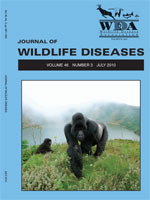A captive striped skunk (Mephitis mephitis) study was conducted between February and June 2004 at the United States Department of Agriculture, Animal and Plant Health Inspection Service, Wildlife Services National Wildlife Research Center, Fort Collins, Colorado, USA. The main objective was to determine the percentage of adult striped skunks that were marked after consuming placebo oral rabies vaccine (ORV) baits containing 100 mg of an experimental microencapsulated (coated microparticle) tetracycline hydrochloride biomarker. Biomarkers were identified in the canine teeth and mandibles of five of five skunks that consumed an ORV bait. A second objective was to determine if the microencapsulated tetracycline was resistant to photochemical conversion from tetracycline to epitetracycline. After 15 days of exposure, conversion from tetracycline to epitetracycline concentration in the microencapsulated product (mean 1.9% conversion, SD=1.24) was significantly less (P=0.006) than the pure-grade tetracycline powder (mean 7.5% conversion, SD=1.37). Results support the use of microencapsulated tetracycline hydrochloride as a biomarker in circumstances where the use of conventional powdered tetracycline hydrochloride is not feasible due to ORV bait design constraints.
How to translate text using browser tools
1 July 2010
Response of Captive Skunks to Microencapsulated Tetracycline
Brandon S. Schmit,
Thomas M. Primus,
Jerome C. Hurley,
Dennis J. Kohler,
Shawna F. Graves
ACCESS THE FULL ARTICLE

Journal of Wildlife Diseases
Vol. 46 • No. 3
July 2010
Vol. 46 • No. 3
July 2010
Coated sachet
Mephitis mephitis
oral rabies vaccination
pen study
striped skunk
tetracycline biomarker




